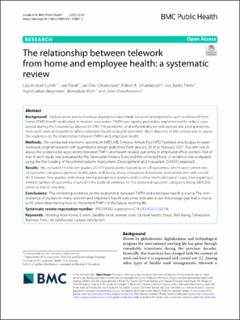| dc.description.abstract | Background Globalization and technological progress have made telework arrangements such as telework from home (TWFH) well-established in modern economies. TWFH was rapidly and widely implemented to reduce virus spread during the Coronavirus disease (COVID-19) pandemic, and will probably be widespread also post-pandemic. How such work arrangements affect employee health is largely unknown. Main objective of this review was to assess the evidence on the relationship between TWFH and employee health. Methods We conducted electronic searches in MEDLINE, Embase, Amed, PsycINFO, PubMed, and Scopus for peer-reviewed, original research with quantitative design published from January 2010 to February 2021. Our aim was to assess the evidence for associations between TWFH and health-related outcomes in employed office workers. Risk of bias in each study was evaluated by the Newcastle-Ottawa Scale and the collected body of evidence was evaluated using the the Grading of Recommendations Assessment, Development and Evaluation (GRADE) approach. Results We included 14 relevant studies (22,919 participants) reporting on 28 outcomes, which were sorted into six outcome categories (general health, pain, well-being, stress, exhaustion & burnout, and satisfaction with overall life & leisure). Few studies, with many having suboptimal designs and/or other methodological issues, investigating a limited number of outcomes, resulted in the body of evidence for the detected outcome categories being GRADED either as low or very low. Conclusions The consisting evidence on the relationship between TWFH and employee health is scarce. The non-existence of studies on many relevant and important health outcomes indicates a vast knowledge gap that is crucial to fill when determining how to implement TWFH in the future working life. | |
